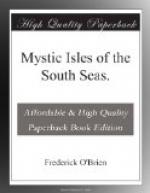It is said that the powerful sentiment among historical nations opposing marriage between brother and sister and other close kindred originated in the desire to make such connections odious, to preserve virtue and decency among those in hourly intimacy. Monarchs and nations long refused to bend to it. The Ptolemies and Pharaohs married incestuously; Cleopatra, her brother. The Ptolemies married their daughters, as did Artaxerxes, who wedded Atossa. The Ballinese married twins of different sex. Abraham married his half-sister by the same father. Moses’s father married his aunt. Jacob took to wife two sisters, his own cousins. In Great Russia until this century a father married his son to a young woman, and then claimed her as his concubine. When a son grew up, he followed his father’s example, though his wife was old and with many children. The Tamils of southeast India, the Malaialais of the Kollimallais hills, have the same custom. Inbreeding maintains a fineness of breed, but at the cost of its vigor. That inbreeding is harmful is fairly certain. Examples to the contrary are numerous in human and animal life. More than nine hundred residents of Norfolk Island are descendants of the mutineers of the British ship Bounty. They were begat by eight of the mutineers, and intermarried for a century. They show no deterioration from this cause.
Hardly any crime is more loathed than incest, but the abomination grew slowly as man progressed. Such ties have been abhorrent for long in most countries. A belief that incestuous children were weak mentally or physically came much later in the ages. The Polynesians must have remarked that inbreeding accentuated the faults in a strain, making for an accumulation of them. This would be a very far advance in human observation; but the Polynesian, by experience, or knowledge brought from his old Asiatic home, must have held such a theory, and sought in the system of adoption, and in not bringing up consanguineous children together, to ward off such misfortune. This at least is a plausible reason for such an unnatural practice among a people so unquestionably child-lovers.
The Marquesans had no totemism to save them. There were no exogamous taboos. The tribe or clan was the chief unit, not the family. The phratry tie was stronger than that of the father and mother. In the totem scheme of other islands and continental groups all the women of his mother’s totem were taboo to a man, though their relationship might be remote. Yet as husband and wife had different totems, and children took their mothers’ totems, a man might in rare instances, even with this barrier, wed his own daughter. This has happened in Buka and in North Bougainville.
The plan of adoption in Polynesia is matched to a degree by the fosterage common in Ireland in early days. There children were sent to be reared in the families of fellow-clansmen of wealth. At a year they left their own thresholds, and their fosterage ended only at marriage. Every fostered person was under obligation to provide for the old age of his foster-parents, and the affection arising from this relationship was usually greater and regarded more sacred than that of blood relationship. This is true to-day of the Tahitians.




